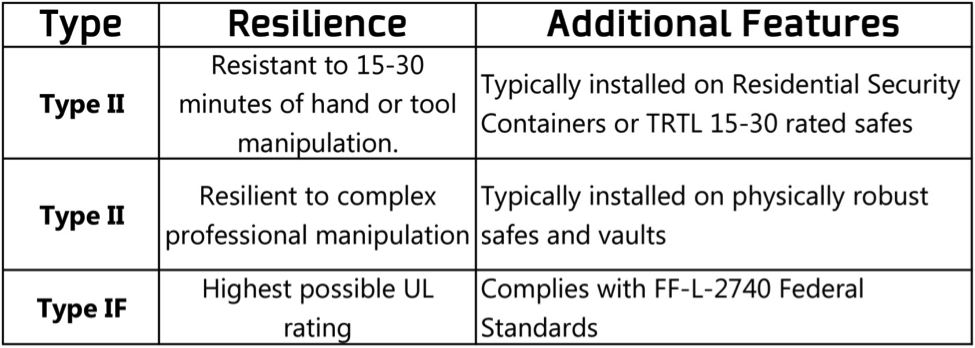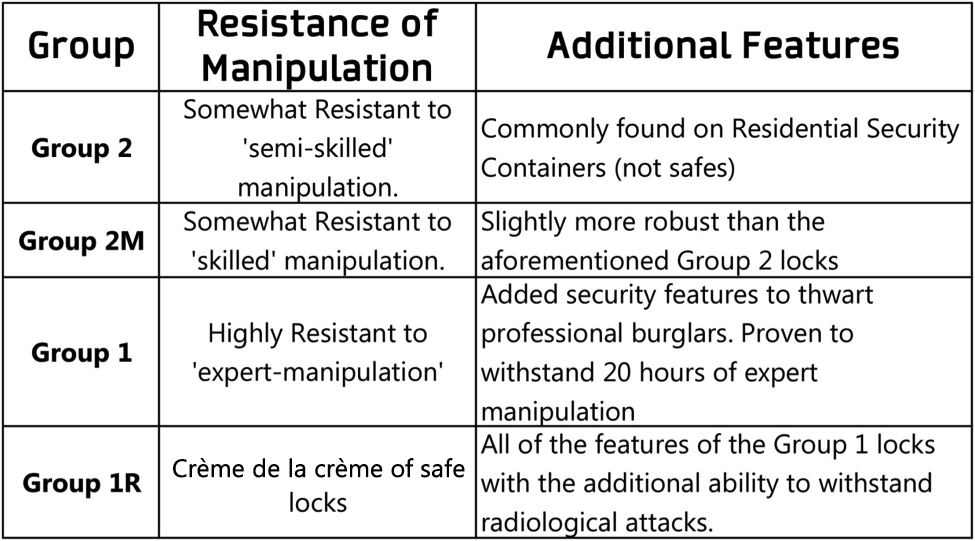 Much like selecting a safe container, when it comes to making a decision such as choosing which type of safe locks you want to use in your facility, you would think that having a wide array of options would be a great thing. However, it’s easy to get overwhelmed with all the choices, thus, making the decision much harder than you had originally anticipated.
Much like selecting a safe container, when it comes to making a decision such as choosing which type of safe locks you want to use in your facility, you would think that having a wide array of options would be a great thing. However, it’s easy to get overwhelmed with all the choices, thus, making the decision much harder than you had originally anticipated.
The best way to begin the process is to decide what exactly you want to protect and the average monetary value of the product. This will narrow down your choices and put you at a much easier starting point. The average safe user isn’t going to use the same precautions to secure $5,000 worth of items and material that they would to secure $5,000,000. That information along with your budget will help you decide on a safe lock that’s most appropriate.
The Different Types
The most popular types of safe locks are electronic and combination locks, but Underwriter Laboratories (UL) has created ratings based on the following characteristics:
- Variety
- Resiliency
- Complexity
Electronic Safe Locks
Underwriter Laboratories has a few stipulations for electronic safe locks such as the fact that they have to employ a relocker and at the bare minimum must have a possibility of one million different combinations.
Typically, these are the go-to locks of choice for the commercial industry. To gain access, a person must enter a code on the lock’s keypad; it’s important to note that the speed of electronic entry is one of the main driving forces behind why this particular lock is so popular. Electronic lock combinations are very simple to change, which is why they’re ideal in a facility that has a high turnover rate. Once an individual is no longer employed at the facility, their code can be deactivated; just as when a new employee is hired, their code is created.
However, it’s important to note that with an electronic lock comes a bit more upkeep. At the very least, it’s important to remember to change the batteries regularly to ensure proper performance and to change the code on a regular basis in order to retain the highest amount of security offered with the lock. If you forget the combination, you simply need to call your service provider or manufacturer. Typically, they’ll be able to walk you through the process of changing the code, but this is only after you’ve identified yourself and you’re on the approved list to change the code.
Combination Locks
Combination locks are rated based on their overall reliability and their resistance to manipulation.
Combination locks have never been the go-to lock of those in commercial settings for a variety of reasons. There’s a lack of security features with combination locks that just doesn’t provide the amount of security one would want for high-valued items. Gaining authorized entry isn’t always easy with combination locks. At times, it can take a few tries to get the combination entered correctly. It also doesn’t help that you almost always need a locksmith to change the combination on a combination lock. If there’s a high turnover rate in employees, changing the combination so frequently can get quite pricey.
Additional Features
With electronic safe locks, you’re going to have several more features available as opposed to any extra features on a combination lock. All of the following options are available when it comes to electronic safe locks:
- Time Delay – used to limit the frequency of opening and to act as a theft deterrent. The delay can typically be set between 1 and 99 minutes.
- Time Delay Override/Armored Car Override – a specific code is set during the lock initialization that allows the lock to be opened by a forced override during a time delay.
- Opening Windows – similar to a time delay, setting opening windows takes the control of opening a step further. Any attempted opening outside of the pre-set time frames are blocked and ignored by the lock. Time frames are customizable; some common utilization includes minutes or seconds following a time delay, or a specific time of day.
- Wrong Try Penalty – also referred to as “penalty modes,” this feature is available in most electronic locks to prevent an individual from running through various combinations quickly. Following the entry of a number of incorrect codes (the number of incorrect tries can be customized), the lock enters “penalty” or “lockout” mode. Depending on user settings and model, the lock will reset after a pre-determined time period following the lockout and will then either allow the same number of incorrect code entries, or will require the correct code be entered the first try to prevent re-entry of lockout mode.
- Dual Custody – this feature prevents a single user from opening the containers. Typically, two entry codes are required for successful opening. Dual codes are usually given to two separate individuals and these assist in deterring internal theft. The credentials aren’t restricted to multiple codes; they could also include utilization of an electronic lock and a key lock, two separate locks or another method of controlling access.
- Audits – most electronic lock manufacturers offer products that allow audit trails to be pulled by authorized individuals with data reports, including the number of times the safe was opened, the code used for entry and the time of these openings. Loss Prevention departments often use these audit trails in internal theft investigations or determining extraction times.
- Duress Mode – an operating code is entered along with a number of series of numbers. Then, through the location’s security system or burglar alarm, the safe alerts law enforcement of a robbery in progress. This feature only works when integrated with the alarm system. Upon entry of the duress code, the lock is released and the container opened.
- Ability to Integrate with a Facility’s Access Control System – allows the ability to interface with the location’s existing access control and alarm system. This feature allows access to audit data in real time, increasing the visibility of who is accessing the safe. Many times this feature will operate in conjunction with the camera in the same room or office as the safe.
Whether or not you choose to go with an electronic safe lock or a combination safe lock, there’s definitely an option for the type of security you want. It’s simply of matter of deciding which type fits best with your needs and the needs of your facility.


